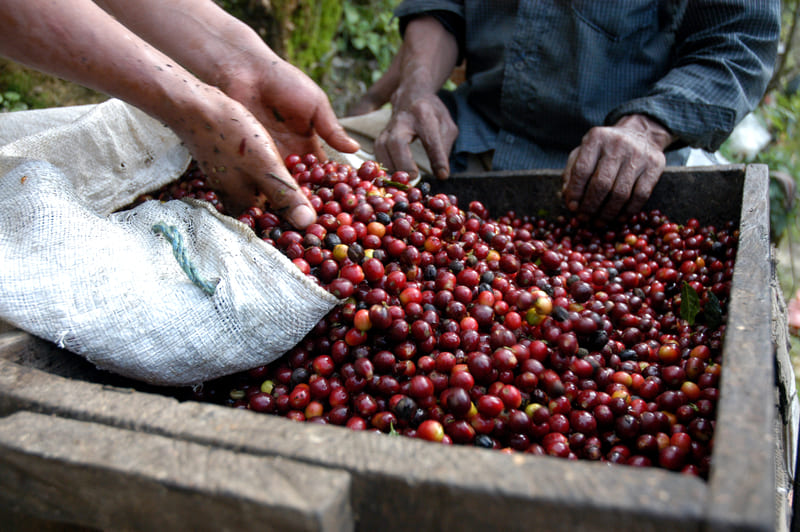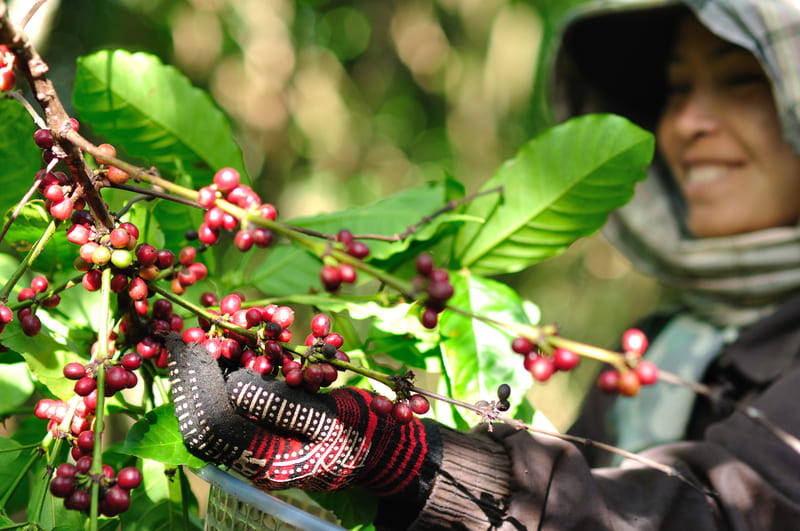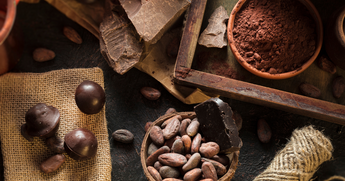From instant coffee to Nespresso coffee pods, the coffee market is a booming industry with plenty to offer. Coffee comes in a variety of strengths and flavours, has various health benefits, and offers a kick of stimulation; nothing can compare to this versatile beverage. Coffee is enjoyed worldwide and it’s no surprise why – the delicious and significant beverage is consumed at all hours of the day all over the globe, bringing people together and keeping cultural traditions alive.
With that being said, coffee must go through several processes before it can land in your cup. From being grown in special conditions, to then being harvested and prepared for consumption, the little beans must travel a long journey over many kilometres. Coffee beans are processed and washed, dried and hulled, roasted, sorted, and finally packed before they can be sold to coffee lovers worldwide. If you would like to know more about where your coffee comes from, and how this delicious concoction is packed into a small coffee pod for your enjoyment, we encourage you to read on.
At Coffee Capsules Direct, we supply a range of coffee products, including coffee pods, filter coffee, coffee beans, coffee machine cleaning pods, flavoured syrups, and more. Famous for our coffee pods, we stock several brands and have various machine-compatible pods for you to choose from. Be sure to check out our coffee pod catalogue and try out some fun flavours for yourself.
The Coffee Zone
The coffee journey first begins with a seed that is planted in a country that receives regular sunlight. The main countries that grow coffee are situated in Central and South America, Africa, Asia, and other parts of the Middle East. These areas are all near the equator and within the tropics, known as the ‘coffee zone’ or the ‘coffee belt’. The coffee zone of the world has the perfect humid climate and temperatures between 15°C and 24°C.
Coffee plants grow best at high altitudes as this plays a role in slowing down the plants’ cherry maturation, creating complex flavours. The higher altitude also positively influences the acidity and the body of the coffee, which is why the coffee-producing countries tend to have mountainous zones. Coffee plants also need plenty of rain throughout the year as well as a dry season during which the coffee cherries can mature.
Here are some well-known coffee-producing countries:
- Colombia: With diverse microclimates and high-altitude plantations, it's no wonder Colombia is known for producing high-quality Arabica coffee. The most well-known regions that produce the best quality Colombian coffee are Hula and Antioquia.
- Brazil: As the largest coffee producer globally, Brazil offers coffee with a mild flavour and these beans are often used in blends. The country has a vast and diverse landscape which provides excellent conditions for growing coffee.
- Ethiopia: Ethiopia is considered the birthplace of coffee and has a rich coffee culture. This country is known for producing a variety of Arabica coffees with distinctive flavours of fruity and floral notes.
- Vietnam: Thanks to its climate and topography, with particular reference to the Central Highlands, Vietnam has become a significant player in the global coffee market, producing delicious Robusta coffee.
- Costa Rica: Known for its high-quality Arabica coffee, Costa Rica is another competitor in the global coffee market. The country’s rich volcanic soil, high altitudes, and environmentally friendly coffee production methods are what led to the creation of Costa Rica’s iconic Arabica coffee.
Each of the countries mentioned above are known for producing high-quality coffee thanks to their diverse environments which include mountainous zones and high altitudes, as well as a mixture of both wet and dry climates.
The Long Journey From Seed To Cup
The two main coffee plant species are Arabica and Robusta. Arabica plants require a high elevation to produce their high-quality beans, while Robusta is hardier and can tolerate lower altitudes. The first step in the coffee making process is deciding which of these species are going to be planted and where.
Growing Coffee Plants
If producers are growing coffee plants from seeds, they will need to plant them in a nursery and wait for them to grow a few inches. Once they have turned into seedlings, they can be transplanted into their final planting site. In the early stages of growing, coffee plants enjoy shade rather than harsh sunlight. Coffee plants also prefer a well-draining and slightly acidic soil that is rich in organic matter. Regularly adding compost and organic fertilisers can improve soil fertility and produce high-quality coffee beans that are rich in flavour.
Coffee plants also need consistent watering and prefer evenly moist soil that is not waterlogged. As the coffee plant grows, it will need to be pruned to promote air circulation throughout the plant – farmers will remove dead or diseased branches and train the plant to have a single main trunk. After 2-4 years, the coffee plants should begin flowering, followed by the development of small green coffee cherries. These cherries take a few months to ripen and turn red or purple when they are ready to be harvested.

Harvesting Coffee Plants
Once the coffee cherries have turned red or purple, they are ready to be harvested. In many regions, harvesting is done by hand. The skilled workers, also known as pickers or harvesters, carefully identify and pick the ripe coffee cherries. Overripe or underripe cherries can affect the coffee’s flavour and quality, which is why the workers must be experienced in coffee harvesting and know what to look out for when picking ripe cherries. In other countries, harvesting is done using mechanical harvesters that strip the cherries from the trees. This method is more efficient but does lack the precision of manual harvesting which is needed when producing high-quality coffee.
The cherries are then gently handled and sorted to remove debris, leaves, and underripe and overripe cherries. They are then transported to the processing facilities where they will undergo various processing methods and be turned into coffee that can be brewed.
Processing Coffee Cherries
The coffee processing methods are crucial in determining the flavour of the final coffee bean product. The outer layer of the coffee cherry is removed to access the small coffee bean inside. The three different types of coffee processing methods are the washed (wet) process, natural (dry) process, and honey (pulled natural) process.
1. Washed (Wet) Process
During the wet process, the cherries are first softened in water-filled vats before they are de-pulped. Next, the harvested coffee cherries’ outer skin, or husk, and pulp are removed and often used to make cascara. The beans are then fermented in water for around 12-72 hours, breaking down the remaining mucilage from the skin and pulp. After fermenting, the beans are washed, leaving the clean coffee beans behind.
Using a mechanical dryer or by leaving them in the sun, the beans are dried until they reach an optimal moisture content, usually taking between 1-3 months. Once the coffee beans finish maturing, they can then be sorted, graded, scored, packaged, and finally shipped. Coffee beans that are processed using a washed (wet) method have a clean and bright profile with a pronounced acidity.
2. Natural (Dry) Process
The natural (dry) method involves letting the cherries dry with the full fruit still intact, creating a more fruity and intense flavoured coffee bean. The drying process is much longer as well, spanning several weeks, with the cherries needing to be turned regularly to ensure even drying. Once fully dried, the outer layers of the cherry are removed, leaving behind the clean coffee bean.
3. Semi-Dried/ Honey (Pulped Natural) Process
During this method, only the skin of the cherry is removed and the coffee beans are left behind with most of the mucilage and fruit intentionally still attached. The beans are set out to dry and must be moved constantly to prevent fungal or mould infections. By leaving the coffee cherry’s fruit and mucilage on during the drying process, the beans are given a distinct fruity flavour. Compared to the washed processes, less water is used, making the honey (pulped natural) method a more environmentally-friendly way of processing coffee cherries.
Honeyed coffee can be classified in three categories, depending on how much pulp was left on the coffee beans:
- White: Almost completely washed with a small amount of ferment concentration left intact.
- Yellow, Orange, and Red: Somewhere in between white and black.
- Black: Almost fully natural, creating a bit more complexity, restraint, and elegance.
Each method of processing the coffee beans influences the coffee’s flavour. Choosing which process to use depends on how big the coffee farm is, how much access to water is available, as well as regional traditions and other climate considerations.

Hulling, Roasting, Sorting, And Packing
Now that the “green coffee” beans are dried, they can go through a process of hulling, where the outer layers of the coffee bean are removed. This outer layer protects the bean during the drying process and so when it is removed after being dried, the true flavours of the coffee bean emerge. Using mechanical or manual hullers, the beans are cracked and the hull or parchment surrounding the bean is removed.
The beans are now ready to be roasted. This is a crucial step because it transforms the coffee beans into the aromatic and flavourful coffee beans that we know and love. The coffee beans are roasted using a method of either drum roasting, air roasting, or fluid bed roasting. There are different levels of roasting too; light, medium, and dark, each offering a distinct flavour profile. This step is a skillful process and requires precision to achieve the desired results.
Once the roasting is complete, the coffee beans are sorted and categorised based on their size, weight, and quality. Automated machines sort the coffee beans, removing any defective beans, impurities, and foreign matter, leaving behind high-quality and uniform coffee beans.
The processed coffee beans are then ready to be packed and sealed for distribution. The packaging must be vacuum sealed or undergo nitrogen flushing to prevent the beans from going bad. Once this step is complete, the beans are ready to be transported, sold, and consumed by coffee lovers all over the world.
Nespresso Coffee Pods: From Coffee Bean To Coffee Pod
Roasted coffee beans are ground to the perfect size for capsule brewing, using a grinding machine. The coffee is then measured precisely and sealed into individual plastic and/or aluminium capsules. The small capsules are packaged into airtight containers that have protective layering, helping to preserve the freshness of the coffee and protect it from sun and moisture.
The coffee pods are then transported to distributors, like us at Coffee Capsules Direct, where they are then sold to the public. Needless to say, coffee goes through a long journey before it can be poured into your cup, but the trip is well worth the destination!

About Coffee Capsules Direct
At Coffee Capsules Direct, we stock a wide variety of coffee pods, ground coffee, coffee beans, and other coffee-related products. We have plenty of reputable coffee brands available for you to choose from, along with affordable bulk offerings and fantastic deals. Be sure to check out our website and find out what delicious flavours we have available for your specific coffee pod machine.
Indulge in the rich and convenient world of premium coffee capsules at Coffee Capsules Direct. For more information, check out our coffee blog or get in contact. We would love to help you find the perfect coffee suited to you and your daily routine.
















